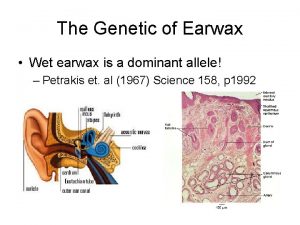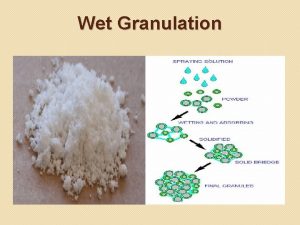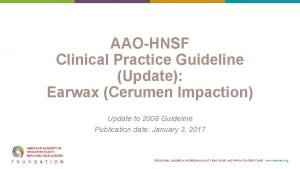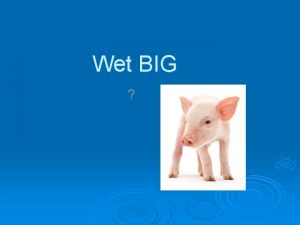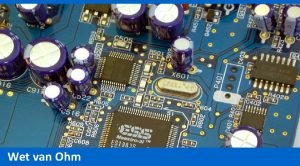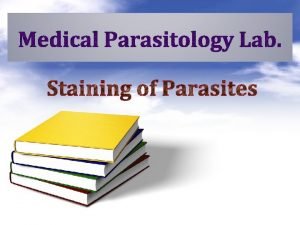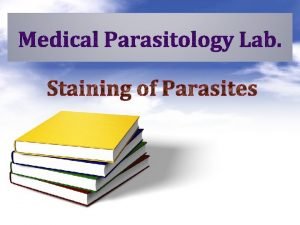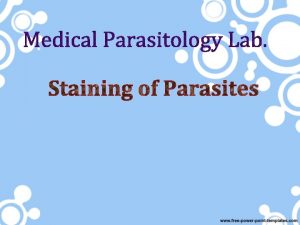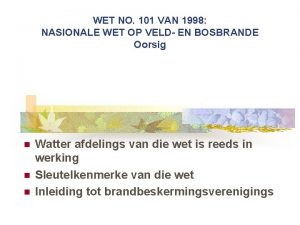The Genetic of Earwax Wet earwax is a





















- Slides: 21

The Genetic of Earwax • Wet earwax is a dominant allele! – Petrakis et. al (1967) Science 158, p 1992

World wild distribution of earwax types Open: dry type Dark: wet type Yoshiura (2006) Nat. Genetics

Earwax type linked to a disease? • Japanese Case Report: – A Paroxysmal kinesigenic choreoathetosis, (PKC, 陣發性運動障礙性疾病) patient who told that six people in her family also had choreoathetosis, and that those with the disease had wet earwax. – Wet earwax is rare in Japan and PKC is rare, too! – The cause of PKC is still unknown but seem linked to chromosome 16 near centremere • Swoboda, et al. Neurology 2000; 50: 224 -30.

Genetic marker typing LOD > 3 : evidence of linkage




Recombination rate Genotype A B (n 1) a b (n 2) A b (n 3) A B (n 4) Total Experiment 1 17 14 8 11 50 Experiment 2 34 28 16 22 100 總樣品數 互換率 θ 範圍 [0, 0. 5] 當 θ = 0 代表完全連鎖 當 θ = 0. 5 代表不連鎖

LOD score • logarithm (base 10) of odds • Developed by Newton E. Morton • NR: non recombination; R: recombination • LOD score > 3. 0: evidence for linkage. (A score of 3. 0 means the likelihood of observing the given pedigree if the two loci are not linked is less than 1 in 1000). • LOD score < -2. 0: evidence to exclude linkage

108 people: 64 wet earwax; 54 dry earwax

More detail study • More microsatellite markers • Use SNP study • 37 SNPs used • rs 17822931 in ABCC 1 exon 4 (538 G A, G 180 R) • rs 6500380 in LONPL intron 12 (A G) • ss 49784070 in LONPL intron 14 (A G)

SNP • Single nucleotide polymorphism (SNP, pronounced snip) • Within a population, SNPs can be assigned a minor allele frequency (>1%) • may fall within coding sequences of genes, non-coding regions of genes, or in the intergenic regions between genes • synonymous or nonsynonymous • Missense or nonsense

How to find out new SNP? • Sequencing • SSCP (single strand conformation polymorphism)

How to determine SNP types? • SNP array

• Next Generation Screening® microarray with 25, 000 features

Genotyping of three SNPs • • Dry earwax (63/64): AA-AA-AA Dry earwax (1/64): GA-GA-GA Wet earwax (6/54): GG-GG-GG Wet earwax (33/54): GA-GA-GA Wet earwax (15/54): AA-AA-AA Only two haplotypes in Japan; Phenotype - genotype inconsistency

Do more case study • • • New series of 126 cases Dry type (87/88): AA homozygotes Wet type (38/38) GA or GG Only rs 17822931 is nonsynonymous Dry type is recessive

What happened to 1/88? • • A allele to dry type, G allele to wet type One exception is dry type with GA allele Sequence the gene of ABCC 11 G allele had a 27 -bp deletion (3939 -3965) in exon 29

What is the function ABCC 11? • Multidrug resistance-associated protein 8 (MRP 8) Rs 17822931 G 180 R

Effect of SNP rs 17822931 • Dry type: A allele G 180 R: Low activity in c. GMP transport Low lipophiles secretion

Genetics Leads the Bioscience Researches 10 9 論文發表篇數 8 7 6 5 4 3 2 1 0 2001 2002 2003 2004 2005 年份 2006 2007 2008 2009
 Wet wet wet
Wet wet wet Earwax type genetics
Earwax type genetics Genetic programming vs genetic algorithm
Genetic programming vs genetic algorithm What is gene flow and genetic drift
What is gene flow and genetic drift Gene flow vs genetic drift
Gene flow vs genetic drift Genetic drift vs genetic flow
Genetic drift vs genetic flow Genetic programming vs genetic algorithm
Genetic programming vs genetic algorithm Kể tên các môn thể thao
Kể tên các môn thể thao Công của trọng lực
Công của trọng lực Thế nào là mạng điện lắp đặt kiểu nổi
Thế nào là mạng điện lắp đặt kiểu nổi Hình ảnh bộ gõ cơ thể búng tay
Hình ảnh bộ gõ cơ thể búng tay Dot
Dot Thế nào là sự mỏi cơ
Thế nào là sự mỏi cơ Vẽ hình chiếu đứng bằng cạnh của vật thể
Vẽ hình chiếu đứng bằng cạnh của vật thể Phản ứng thế ankan
Phản ứng thế ankan Chó sói
Chó sói Thiếu nhi thế giới liên hoan
Thiếu nhi thế giới liên hoan Sự nuôi và dạy con của hổ
Sự nuôi và dạy con của hổ điện thế nghỉ
điện thế nghỉ Một số thể thơ truyền thống
Một số thể thơ truyền thống Trời xanh đây là của chúng ta thể thơ
Trời xanh đây là của chúng ta thể thơ Lp html
Lp html

